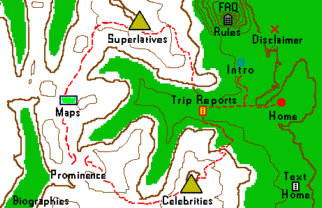
| Denali: A Crux Move * |

|
Someone once told me that climbing a mountain was a lot like a relationship. The climb has its ups and downsthose bone-tiring moments versus acute, breathtakingly marvelous minutes with slow-slog stretches. Much has been written of climbing Denali and Ill not try and replicate any of that here. I wanted to give you a taste of Denali to whet the appetite. I asked six PCSers, whove been there and back, six questions and I've compiled them ungraded and unnamed, below.
One quote stands out: Denali is really two mountains. From 7000 to 14000, it's like a trek. But, from 14000 on, it's a different mountain entirely. Having a strategy of how you will climb the mountain becomes critical.
Many thanks to: Steve Eckert, Bob Evans, Will Hirst, Tim Hult, Charles Schafer, and Linda Smith.
1. What was unexpected about climbing Denali?
The place is huge [and] bigger than anywhere else Ive been, except maybe Everest Basecamp area. The distances are vast, the glaciers huge, [and] the altitude very high. It was a lot of work. Besides hauling your stuff, you have to build walls out of snow and make a place for your tent. Besides marching up and down Mission Peak, I should have been digging ditches to train! Many people on the mountain were younger and I wish Id had the experience built up at a younger age to climb it. I talked to people on the mountain who were much older than I, so theyre there. How committing and truly raw it was. When you stand on the glacier and look around, all you see are rocks and snowit was just staggering The number of climbers on the mountain and the degree of organization. It starts with the fly-in to the Kahiltna Glacier, where a marked landing strip has been set up in the snow; complete with a woman who is up there the whole climbing season to act as Air Traffic Controller. The sleds stay up at Kahiltna through the season, like grocery shopping carts. The guides maintain the fixed ropes that make the climb possible for people like me. Even though I had heard about the toilet situation, I still found it amazing. Not much [was unexpected]. I grew up in Anchorage. I helped pack expeditions for Ray Genet back in the 70s. My best friend climbed Denali when he was 15.
2. What was expected and planned for in climbing Denali?
Bad weather and high altitude. Meals. Carrying 50 lbs plus pulling the sled. just about every possible contingency, short of a 14000 tsunami.
3. If you had it to do again, what would you do differently?
More than two people would probably be safer, but only if they were all skilled and compatible. We never had any crevasse trouble, but a single person rescue is tricky. More than two people for sure, but picking competent partners outweighs simple quantities of bodies. I neglected to practice lifting the 50 lb pack from the ground onto my back, and, when I got to Denali, that was a problem. I'd bring less food [because] if you have excess food and fuel, you try to give it away so you dont have to haul it out. Use a sled, not a drag bag.
4. In thinking about equipment and hardware, what's the one piece of equipment you wouldn't be without?
Spare gloves. Spare glacier glasses. A sense of humor. Rope most of the climb is glaciated so the prudent thing is to be roped up. For women, the dreaded funnel is a necessity.Dont pack too many warm clothes. Pack what you need and dont pack any more than that. Bring extras of things you cant do without or may easily get blown away; crushed; lost; forgotten: sunglasses, hat and gloves, stove repair kit, extra pot, thermarest repair kit. A bombproof stove is very important. My camera. Actually, there is no one piece of gear that stands above all the rest. Youre trying to survive in a very harsh environment, so you need good quality gear that will enable you to do just that.
5. How did you choose your climbing mates?
I decided to do a guided climb because I didnt think I had the experience or ability to be part of an independent team. I only expected to try it once and a guided trip maximized my chance of success. I got a call from a prior climbing partner that I'd met on a trek in Nepal. They chose me. Reputation. Mutual respect. We both had a fair amount of high altitude experience and he had been on Denali before.
6. If you could give one piece of advice to someone about to climb Denali, what would that be?
Prepare the best you can, but remember a little humility. It doesn't depend on your abilities. It depends on the weather. A 12 year old girl reached the summit the day before I did, but, on other days, famous mountaineers had to turn back. You dont conquer this mountain. If you are lucky, it lets you climb it. Know yourself, know your partner, know your combined limits. You're there to visit and sneak up between storms, not conquer the damn thing. In your zeal to climb the mountain, dont forget to enjoy some of the flavor of the mountain along the way. Weather can impact chances of attaining the summit, but not what a climber can take from the mountain. Have a plan and a strategy of how you will climb the mountain. Be as informed as you can about conditions and the route. Don't confine yourself to reading the park-service provided guide alone. The team must agree in advance what sort of schedule they will follow and what the individual expectations are for this climb. If youre thinking about doing it go! Just go.